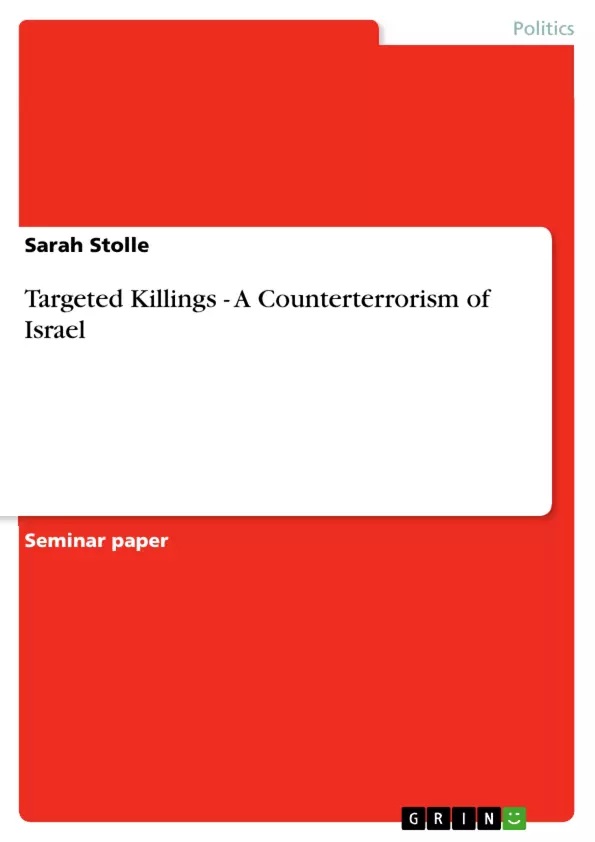[...] After September 11th targeted killings become a usual method to eleminate terrorists. But targeted killings did not arose in 2001. Also in the Cold War there were many targeted attacks on politicians, agents and other undesirable people. The “Licence to Kill” spanninged the whole continent. The whole continent was spanning by the “Licence to kill”. After the end of the Cold War the situation calmed down for a short time. But at the latest with the arising of the terrorism as the enemy of the civil society the state sanctioned killings became popular. The forerunner of targeted killings was Israel, the USA followed after September 11th. They used for example armed drones for killing suspects over a distance of thousands of kilometres. Also Russia uses this method for the fight against terrorism. For example they accomplished a lethal prevention attack on a former Chechenian leader in Katar. One of the most spectacular Israeli targeted killings was the killing of the religious leader of the Palestine Hamas Sheik Yassin. This targeted killing aggravated the Palestinian-Israeli conflict in a strong way. Yassin and his followers who left the mosque were shot out of an helicopter. Besides the targeted killings of members of political and militant movements there are often attacks on Palestinian people who are in no coherence with demonstrations or rebellions. Here are to mention targeted attacks in Palestinian settlements, killings because of carelessness, planless shootings and inconsiderate eleminating of human life. The following work tasks with the targeted killings which Israel practices. Because on the one hand Israel is the forerunner of this method and on the other hand Israel practices this method very often and with an enormous brutality as well as recklessness against the civil society. At first I give some examples of Israeli targeted killings. These case studies conclude killings of the political elite as well as the Palestinian civil society. Other aspects in this essay are the different positions on the Israeli “Politics of Killing”. In this point the positions of Israel, Palestine, the United Nations and the problem of the American position are important. A further feature aspect is the international law. There is the question if targeted killings of terrorists could be accepted in the view of the international law or not.
Inhaltsverzeichnis (Table of Contents)
- Introduction
- Targeted Killings
- Examples of targeted killings
- Targeted killings of political and other leaders
- Sheik Ahmed Yassin and Abd al-Aziz al Rantisi
- Abbas Moussawi
- Abu Ali Mustafa
- Jamal'Abd al Qader'Abd al-Razeq
- The killing of civilians
- Targeted killings of political and other leaders
- Positions to the Israeli targeted killings
- Israel's Position
- Opposites opinions out of the army
- The positions of the arabic world, Palistine and Palistinian groups
- Positions of the State Community
- Comments of the UNO
- The Problems with Current U.S. Policy
- International Law
- The rigth of self-defence
- The difference between combatants and civilians
- The right to life
- The right of a fair lawsuit
- Examples of targeted killings
- Conclusion
Zielsetzung und Themenschwerpunkte (Objectives and Key Themes)
This essay aims to examine the practice of targeted killings by Israel as a counterterrorism strategy, analyzing its legality under international law and exploring the different perspectives surrounding it. It particularly focuses on the Israeli approach to targeted killings, highlighting its frequent use and potential brutality.
- The use of targeted killings as a counterterrorism tactic
- The legality of targeted killings under international law
- The different perspectives on targeted killings from Israel, Palestine, and the international community
- The potential for human rights violations in the context of targeted killings
- The implications of targeted killings for the Palestinian-Israeli conflict
Zusammenfassung der Kapitel (Chapter Summaries)
The essay begins by providing a brief overview of the historical context of targeted killings, tracing their evolution from the Cold War to the post-9/11 era. It then delves into specific examples of Israeli targeted killings, including the assassinations of prominent Palestinian figures like Sheik Ahmed Yassin and Abbas Moussawi.
The essay further explores the positions of various actors on the issue of targeted killings, examining the justifications presented by Israel, the concerns raised by the Palestinian community, and the responses from the international community, including the United Nations.
The final section delves into the legal framework surrounding targeted killings, scrutinizing the applicability of international law principles such as the right to self-defense and the distinction between combatants and civilians. The essay aims to shed light on the complexities and controversies surrounding the use of targeted killings in the context of counterterrorism.
Schlüsselwörter (Keywords)
Targeted killings, counterterrorism, international law, human rights, Israel, Palestine, Palestinian-Israeli conflict, self-defense, military operations, ethical considerations, legal framework, political implications, civilian casualties, international community, United Nations.
- Citation du texte
- Sarah Stolle (Auteur), 2005, Targeted Killings - A Counterterrorism of Israel, Munich, GRIN Verlag, https://www.grin.com/document/60562



